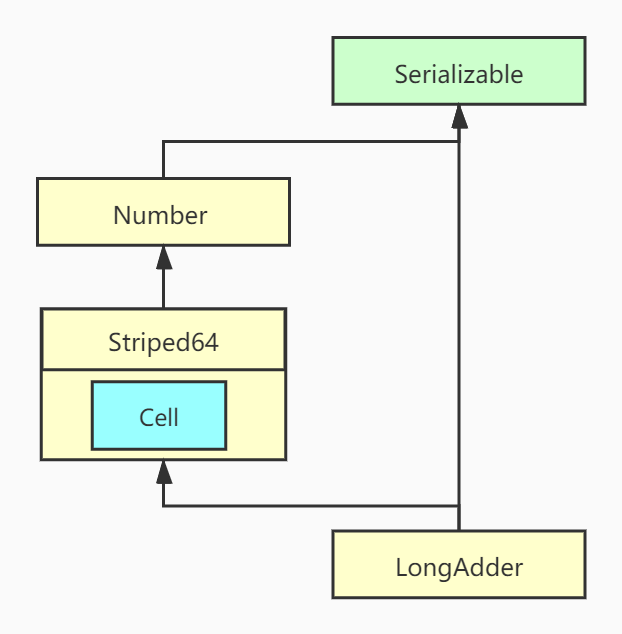功能描述
LongAdder通过创建多个副本对象,解决了多线程使用CAS更新同一个对象造成的CPU阻塞,加快了对线程处理的速度。当多个线程同一时刻更新一个AtomicLong类型的变量时,只有一个线程能够更新成功,其他线程则更新失败,继续尝试更新。

当使用LongAdder类型的变量时,由于副本数组的存在,线程不一定直接更新变量的本身而是更新副本数组,这样多线程请求的对象变多了,从而减少了更新时间,当需要使用变量值时,返回的值是基础变量的值加上数组内每一个副本的值的和。

源码解析
LongAdder继承自Striped64并实现了Serializable接口,而在Striped64类中有一个Cell类

add方法分析
首先从LongAdder类的add方法入手
public void add(long x) {
Cell[] as; long b, v; int m; Cell a;
if ((as = cells) != null || !casBase(b = base, b + x)) {
boolean uncontended = true;
if (as == null || (m = as.length - 1) < 0 ||
(a = as[getProbe() & m]) == null ||
!(uncontended = a.cas(v = a.value, v + x)))
longAccumulate(x, null, uncontended);
}
}
从上面的代码可以看到LongAdder的实现主要依靠的是cells数组,如果cells数组为空的话,则尝试使用cas更新基础变量base,如果成功了,则add成功,方法结束,如果cas更新base失败了,则证明此时有其他线程参与base变量的更新,此后的处理与cells不为空一致(如果cells不为空,则在此次方法执行前就已经有多线程参与了更新)。
当cells数组不为空或者更新base变量失败后,则转而更新cells数组中的副本,此时先判断cells数组是否为空或长度为0,如果为空或长度为0则说明这是第一次操作cells数组,应先初始化cells数组,因此调用方法longAccumulate(x, null, true);
如果cells数组不为空,则尝试直接访问数组中的副本,getProbe方法代码:
static final int getProbe() {
return UNSAFE.getInt(Thread.currentThread(), PROBE);
}
从上面代码可以看到getProbe方法获取了当前线程内的PROBE变量,而PROBE定义在Striped64类中
private static final long PROBE;
static {
try {
UNSAFE = sun.misc.Unsafe.getUnsafe();
Class<?> sk = Striped64.class;
BASE = UNSAFE.objectFieldOffset
(sk.getDeclaredField("base"));
CELLSBUSY = UNSAFE.objectFieldOffset
(sk.getDeclaredField("cellsBusy"));
Class<?> tk = Thread.class;
PROBE = UNSAFE.objectFieldOffset
(tk.getDeclaredField("threadLocalRandomProbe"));
} catch (Exception e) {
throw new Error(e);
}
}
从上面的代码可以看出PROBE来自于Thread类的threadLocalRandomProbe变量,是一个线程级变量。getProbe() & m则是获取当前要更新的cell,如果cell为空的话则调用longAccumulate(x, null, true);方法设置cell的值,如果cell不为空的话则使用cas直接更新cell的值,并将更新结果保存在uncontended中,如果uncontended的值为false(即cas更新失败了,此时应该有多个线程同时访问了一个cell),那么继续调用longAccumulate(x, null, false);方法。
longAccumulate方法分析
从上面的add方法可以看到,getProbe()取得了Thread类中的threadLocalRandomProbe变量,而threadLocalRandomProbe变量的初始值为0,因为getProbe()方法参与了多线程访问哪一个cell的定位,因此getProbe()的值不可能为0,那么threadLocalRandomProbe变量是在哪里赋值的呢?
在add方法中观察到,没当方法进行不下去时(base变量更新失败,cells为空,cell更新失败),都会调用longAccumulate方法,因此longAccumulate一定是涉及了cells数组的初始化和扩容,观察longAccumulate方法代码:
final void longAccumulate(long x, LongBinaryOperator fn,
boolean wasUncontended) {
int h;
if ((h = getProbe()) == 0) {
ThreadLocalRandom.current(); // force initialization
h = getProbe();
wasUncontended = true;
}
boolean collide = false; // True if last slot nonempty
for (;;) {
Cell[] as; Cell a; int n; long v;
if ((as = cells) != null && (n = as.length) > 0) {
if ((a = as[(n - 1) & h]) == null) {
if (cellsBusy == 0) { // Try to attach new Cell
Cell r = new Cell(x); // Optimistically create
if (cellsBusy == 0 && casCellsBusy()) {
boolean created = false;
try { // Recheck under lock
Cell[] rs; int m, j;
if ((rs = cells) != null &&
(m = rs.length) > 0 &&
rs[j = (m - 1) & h] == null) {
rs[j] = r;
created = true;
}
} finally {
cellsBusy = 0;
}
if (created)
break;
continue; // Slot is now non-empty
}
}
collide = false;
}
else if (!wasUncontended) // CAS already known to fail
wasUncontended = true; // Continue after rehash
else if (a.cas(v = a.value, ((fn == null) ? v + x :
fn.applyAsLong(v, x))))
break;
else if (n >= NCPU || cells != as)
collide = false; // At max size or stale
else if (!collide)
collide = true;
else if (cellsBusy == 0 && casCellsBusy()) {
try {
if (cells == as) { // Expand table unless stale
Cell[] rs = new Cell[n << 1];
for (int i = 0; i < n; ++i)
rs[i] = as[i];
cells = rs;
}
} finally {
cellsBusy = 0;
}
collide = false;
continue; // Retry with expanded table
}
h = advanceProbe(h);
}
else if (cellsBusy == 0 && cells == as && casCellsBusy()) {
boolean init = false;
try { // Initialize table
if (cells == as) {
Cell[] rs = new Cell[2];
rs[h & 1] = new Cell(x);
cells = rs;
init = true;
}
} finally {
cellsBusy = 0;
}
if (init)
break;
}
else if (casBase(v = base, ((fn == null) ? v + x :
fn.applyAsLong(v, x))))
break; // Fall back on using base
}
}
bk




